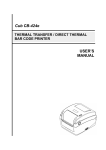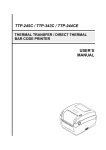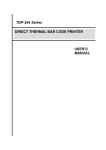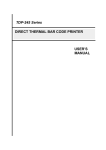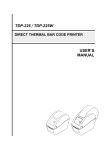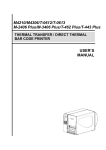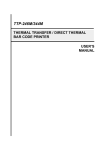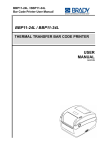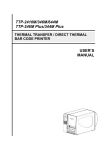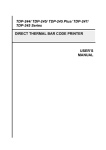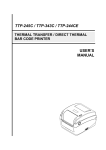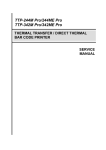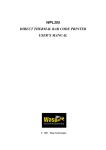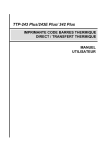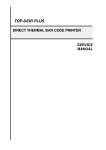Download TTP-248M USER`S MANUAL THERMAL TRANSFER
Transcript
TTP-248M THERMAL TRANSFER / DIRECT THERMAL BAR CODE PRINTER USER’S MANUAL Copyright Declaration Information in this subject to change without notice and does not represent a commitment on the part of TSC Auto ID Technology Co., Ltd.. No part of this manual may be reproduced or transmitted in any form by any means, for any purpose other than the purchaser’s personal use, without the expressed written permission of TSC Auto ID Technology Co., Ltd.. i The FreeType Project LICENSE 2000-Feb-08 Copyright 1996-2000 by David Turner, Robert Wilhelm, and Werner Lemberg Introduction The FreeType Project is distributed in several archive packages; some of them may contain, in addition to the FreeType font engine, various tools and contributions which rely on, or relate to, the FreeType Project. This license applies to all files found in such packages, and which do not fall under their own explicit license. The license affects thus the FreeType font engine, the test programs, documentation and make files, at the very least. This license was inspired by the BSD, Artistic, and IJG(Independent JPEG Group) licenses, which all encourage inclusion and use of free software in commercial and freeware products alike. As a consequence, its main points are that: We don't promise that this software works. However, we will be interested in any kind of bug reports. (`as is' distribution) You can use this software for whatever you want, in parts or full form, without having to pay us. (`royalty-free' usage) You may not pretend that you wrote this software. If you use it, or only parts of it, in a program, you must acknowledge somewhere in your documentation that you have used the FreeType code. (`credits') We specifically permit and encourage the inclusion of this software, with or without modifications, in commercial products. We disclaim all warranties covering The FreeType Project and assume no liability related to The FreeType Project. Legal Terms Definitions Throughout this license, the terms `package', `FreeType Project', and `FreeType archive' refer to the set of files originally distributed by the authors (David Turner, Robert Wilhelm, and Werner Lemberg) as the `FreeType Project', be they named as alpha, beta or final release. `You' refers to the licensee, or person using the project, where `using' is a generic term including compiling the project's source code as well as linking it to form a `program' or `executable'. This program is referred to as `a program using the FreeType engine'. This license applies to all files distributed in the original FreeType Project, including all source code, binaries and documentation, unless otherwise stated in the file in its original, unmodified form as distributed in the original archive. If you are unsure whether or not a particular file is covered by this license, you must contact us to verify this. The FreeType Project is copyright (C) 1996-2000 by David Turner, Robert Wilhelm, and Werner Lemberg. All rights reserved except as specified below. 1. No Warranty THE FREETYPE PROJECT IS PROVIDED `AS IS' WITHOUT WARRANTY OF ANY KIND, EITHER EXPRESS OR IMPLIED, INCLUDING, BUT NOT LIMITED TO, WARRANTIES OF MERCHANTABILITY AND FITNESS FOR A PARTICULAR PURPOSE.IN NO EVENT WILL ANY OF THE AUTHORS OR COPYRIGHT HOLDERS BE LIABLE FOR ANY DAMAGES CAUSED BY THE USE OR THE INABILITY TO USE, OF THE FREETYPE PROJECT. ii 2. Redistribution This license grants a worldwide, royalty-free, perpetual and irrevocable right and license to use, execute, perform, compile, display, copy, create derivative works of, distribute and sublicense the FreeType Project (in both source and object code forms) and derivative works thereof for any purpose; and to authorize others to exercise some or all of the rights granted herein, subject to the following conditions: Redistribution of source code must retain this license file (`LICENSE.TXT') unaltered; any additions, deletions or changes to the original files must be clearly indicated in accompanying documentation. The copyright notices of the unaltered, original files must be preserved in all copies of source files. Redistribution in binary form must provide a disclaimer that states that the software is based in part of the work of the FreeType Team, in the distribution documentation. We also encourage you to put an URL to the FreeType web page in your documentation, though this isn't mandatory. These conditions apply to any software derived from or based on the FreeType Project, not just the unmodified files. If you use our work, you must acknowledge us. However, no fee need be paid to us. 3. Advertising Neither the FreeType authors and contributors nor you shall use the name of the other for commercial, advertising, or promotional purposes without specific prior written permission. We suggest, but do not require, that you use one or more of the following phrases to refer to this software in your documentationor advertising materials: `FreeType Project', `FreeType Engine',`FreeType library', or `FreeType Distribution'. As you have not signed this license, you are not required to accept it. However, as the FreeType Project is copyrighted material, only this license, or another one contracted with the authors, grants you the right to use, distribute, and modify it. Therefore, by using, distributing, or modifying the FreeType Project, you indicate that you understand and accept all the terms of this license. 4. Contacts There are two mailing lists related to FreeType: [email protected] Discusses general use and applications of FreeType, as well as future and wanted additions to the library and distribution. If you are looking for support, start in this list if you haven't found anything to help you in the documentation. [email protected] Discusses bugs, as well as engine internals, design issues, specific licenses, porting, etc. http://www.freetype.org Holds the current FreeType web page, which will allow you to download our latest development version and read online documentation. iii CONTENTS Copyright Declaration ................................................................................................... i 1. PRODUCT INTRODUCTION ................................................................................ 1 1.1 Compliances .................................................................................................. 1 2. GETTING STARTED ............................................................................................. 3 2.1 Unpacking and Inspection ............................................................................. 3 2.2 Equipment Checklist ...................................................................................... 3 2.3 Printer Parts .................................................................................................... 4 2.4 Buttons and Indicators ................................................................................... 5 3. Set Up ................................................................................................................... 7 3.1 Setting Up the Printer .................................................................................... 7 3.2 Ribbon Installation ......................................................................................... 7 3.3 Label Roll Installation ..................................................................................... 8 3.4 Self-peeling Function...................................................................................... 9 3.5 Cutter Module Installation ............................................................................. 10 3.6 Self-test ........................................................................................................ 11 3.7 Dump Mode ................................................................................................. 11 4. USING TTP-248M ............................................................................................... 13 4.1 Power-on Utilities ......................................................................................... 13 4.1.1 Gap/Black Mark Sensor Calibration Utility............................................. 13 4.1.2 Printer Initialization ................................................................................ 14 4.2 Troubleshooting Guide ................................................................................ 16 5. PRINTER CLEANING ......................................................................................... 18 5.1 Print Head Cleaning ..................................................................................... 18 5.2 Printer Cover Cleaning ................................................................................. 18 5.3 Internal Parts Cleaning ................................................................................. 18 APPENDIX LCD Control Panel Operation Map ........................................................ 20 i 1. PRODUCT INTRODUCTION Thank you very much for purchasing TSC TTP-248M bar code printer. TTP248M comes with rugged steel construction and durable metal mechanism ensuring the ability to work under extreme industrial applications. TTP-248M is equipped with a 32-bit RISC processor, which offers up to 203.2 mm/sec (8”/sec) print speed. With back-lit LCD display, printer status can be managed easier and operated more user friendly. The moveable sensor design can meet wide range of label media. All of the most frequently used bar code formats are available in TTP-248M. Fonts and bar codes can be printed in any one of the four directions. This printer provides a choice of five different sizes of alphanumeric font, OCR-A, OCR-B and one true type font. TTP-248M is the most cost-effective and high performance in its class! 1.1 Compliances FCC Class A FCC Part 15: 2002/08/20 ANSI.C63.4: 1992 This equipment has been tested and found to comply with the limits for a Class A digital device, pursuant to Part 15 of the FCC Rules. These limits are designed to provide reason-able protection against harmful interference when the equipment is operated in a commercial environment. This equipment generates, uses and can radiate radio frequency energy, and if not installed and used in ac-cordance with the instruction manual, may cause harmful interference to radio communications. Operation of this equipment in a residential area is likely to cause harmful interference in which the user will be required to correct the interference at his or her own expense. CE EN55022 :1998 class A EN61000-3-2 :1995 class A EN61000-3-3 :1995 EN55024 : 1998 1 UL/CUL TÜ V/Safety EN 60950/A11: 1997 Wichtige Sicherheits-Hinweise 1. 2. 3. 7. Bitte lesen Sie Diese Hinweis sorgfältig durch Heben Sie diese Anleitung fűr den späteren Gebrauch auf. Vor jedem Reinigen ist das Gerät vom Stromentz zu trennen. Verwenden Sie Keine Flűssig-oder Aerosolreiniger. Am besten eignet sich ein angefeuchtetes Tuch zur Reinigung. Die Netzanschlußsteckdose soll nahe dem Gerät angebraucht und leicht zugänglich sein. Das Gerät ist vor Feuchtigkeit zu schűtzen. Bei der Aufstellung des Gerätes ist auf sicheren Stand zu achten. Ein Kippen oder Fallen könnte Beschädigungen hervorrufen. Beáchten Sie beim Anschluß an das stromnetz die Anschlußwerte. 8. Dieses das Gerät kann bis zu einer Außentemperatur von maximal 40 ℃ 4. 5. 6. betieben werden. BSMI 2 2. GETTING STARTED 2.1 Unpacking and Inspection After receiving the bar code printer, carefully inspect the device and its packaging. The printer is specially packaged to withstand damage in shipping. In case of evident damage, contact the carrier directly to specify the nature and extent of damage. Please retain the packaging materials in case you need to reship the printer. 2.2 Equipment Checklist One TTP-248M printer unit One ribbon paper core One quick installation guide One power cord One centronics interface cable One 3” paper core adapter One Windows software/driver CD disk One internal rewinder Separately purchased items may also be included. These additional items may include: Cutter module Peel-off sensor Programmable Stand-alone keyboard KU-007 Plus Memory module Internal print server External 802.11b/g print server If any part is missing, please contact the Customer Service Department of your purchased reseller or distributor. 3 2.3 Printer Parts LED Indicator LCD Display Printer Cover Buttons Figure 1. Top front view Laud Buzzer Centronics Port RS-232C Port External Label Feed Opening Power Switch Power Supply Connector Figure 2. Printer rear view 4 Ribbon Supply Spindle Ribbon Rewind Spindle Ribbon Tension Knob Label Spindle Rewind Spindle Paper Clamp Print Head Pressure Adjustment Knob Label Rewind Spindle Label Guide Carriage Release Lever Media Guide Bar Figure 3. Printer interior view 2.4 Buttons and Indicators Power Indicator When the printer is in the power-on condition, the Power indicator is lit on. On-Line Indicator This green On-Line indicator is lit on when the printer is ready; the On-Line indicator blinks when pressing PAUSE button. Error Indicator The red Error indicator illuminates in the event of a printer error, such as memory full, carriage open, cutter error and so forth. MENU/SELECT Button Provided with a built-in menu, the printer allows the user to directly set printing parameters or view printer status on the LCD display. Press the MENU button to enter printer setup mode. Press the MENU button again to proceed the cursor to the next item. The setup is comprised of these major items: Printer Setup, Sensor Setup, System Setup, File Setup and Printer Test. For more information, please refer to Appendix for the structure and operation logic of the menu. PAUSE/EXE/INC Button 5 This button combines three functions: 1. PAUSE button if the printer is in the Ready status. By pressing the PAUSE button: (1) the printer stops at the completion of printing of the current label,(2) the On-Line LED flashes, and (3) the printer holds all data in memory. This allows for trouble-free replacement of label stock and thermal transfer ribbon. A second depression of the PAUSE button will restart the printer. 2. EXE/INC button if in the setup mode. Press EXE/INC button to increase the value of parameters, or execute the selected item. FEED/DEC Button This button also has dual functions: Feed one label and decrease the value of parameters. Press the FEED button, the printer will advance one label. Press the DEC button to change parameter settings or exit the submenu. Stripper/Rewind Plate The stripper/rewind plate can be used for strip and label rewind mode. Please refer to the instruction of the sticker on the stripper/rewind plate to install this plate. Carriage Release Lever When opening the Carriage Release Lever, On-Line LED is lit off, the LCD display shows “Carriage Open”. After engage the carriage release lever, press the FEED button, printer will re-register the label and then shows READY on the LCD display, and the screen will return to ready condition. Print Head Pressure Adjustment Knob The print head pressure adjustment knob has 5 levels of adjustment. Because the printer’s paper alignment is to the left side of mechanism, different media widths require different pressure to print correctly. Therefore it may be necessary to adjust the pressure knob to get your best printout quality. For example, if the label width is 4”, adjust both print head pressure adjustment knobs to the same level. If the label is less than 2” wide, increase the left print head pressure adjustment knob and decrease the right side pressure to level 1. Ribbon tension adjustment knob The ribbon tension adjustment knob offers 6 levels of tension to apply to 6 different width of ribbon. Turn the ribbon tension knob clockwise and you will hear a light click sound as the gear changes. The level of rewind ribbon is from loose to tight, level 0 to level 5. You will hear a louder click for level 0. 3. Set Up 3.1 Setting Up the Printer Place the printer on a flat, secure surface and make sure the POWER switch is off. Connect the printer to the computer with the provided RS-232C or Centronics cable. Plug the power cord into the power supply connector at the rear of the printer, and then plug the power cord into a properly grounded power outlet. 3.2 Ribbon Installation 1. 2. 3. Open the printer right side cover. Disengage the printer carriage lever. Install a new ribbon roll onto the ribbon supply spindle. ※ It is to be noticed that ribbon should be placed to the left end of spindle. Figure 4. Ribbon installation 7 4. 5. 6. Place an empty paper core onto the ribbon rewind roll. (The diameter of empty paper core must be larger then 34 mm) Pull the ribbon roll leading edge forward through the ribbon sensor. Attach the ribbon leading edge (with a tape) to the empty paper core. Manually rotate the ribbon rewind roll until the ribbon overlaps the ribbon leading edge and stretches tight. Figure 5. Installation of ribbon. 3.3 Label Roll Installation 1. 2. 3. Insert the label supply roll into the label spindle. Pull the label roll leading edge forward through the black media guide bar, gap/black mark sensor and place the label leading edge onto the platen roller. Adjust the label guide to meet the width of the label, and buckle it onto the black media guide bar. 8 4. 5. 6. Engage the carriage release lever. Close the printer cover. Switch on the power. Now, the printer is ready to print. Figure 6. Insert label supply roll into label spindle. 3.4 Self-peeling Function 1. 2. 3. 4. Remove the cutter module (if installed) and the stripper/rewind plate. Install the stripper/rewind plate in the direction with the sticker “The side of plate is used with tear-off mode, cutter mode and peel-off mode” faced outside. Wind back the label leading edge. Clip the label on the label rewind spindle by the paper clamp. 9 Figure 7. Feed path for the printer media. 3.5 Cutter Module Installation 1. 2. 3. 4. 5. Uninstall the peel-off sensor and stripper/rewind plate. Plug the mini DIN cable into the socket under the platen. Install the stripper/rewind plate. It is to be noted that the cutter module bracket should be mounted into the slots, which are on the base of the printer. Fix the cutter module on the printer with a screw. Cutter Module Figure 8. Cutter module installation 10 3.6 Self-test To initiate the self-test mode, depress the MENU button. Press MENU button to scroll the cursor to Printer test. Press EXE button to enter the submenu and press MENU button to “Printer Config”. item. Press EXE button to print printer internal setting. In self-test, a check pattern is used to check the performance of the thermal printhead. Following the check pattern, the printer prints internal settings as listed below: 1. Printer model and firmware version 2. Check sum 3. Serial port setting 4. Code page setting 5. Country code setting 6. Print speed setting 7. Print density setting 8. Label size setting 9. Gap (Bline) width and offset setting 10. Backing paper transparence 11. File list 12. Memory available Figure 9. Printout of self-test 3.7 Dump Mode To enter dump mode, please press MENU button to scroll the cursor to “Printer Test” then Press EXE button to enter the submenu. Press MENU button to scroll dump mode. Press EXE button to select line dump mode or page dump mode. Press MENU button to select EXIT to enter dump mode. In this mode, any 11 characters sent from the host computer will be printed in two columns, as shown in Figure 11. The characters received will be printed in two columns as below: on the left side of the paper are the characters received and on the right side are the corresponding hexadecimal values. This is very helpful to users for the verification of programming commands or debugging of printer programs. Reset the printer by pressing the FEED button. Figure 10. Printout of dump mode 12 4. USING TTP-248M 4.1 Power-on Utilities There are two power-on utilities to calibrate sensor and initialize TTP-248M hardware. These utilities are activated by pressing the PAUSE button, PAUSE and FEED buttons and turning on the printer power simultaneously. The utilities are listed as below: 1. Gap/black mark sensor calibration 2. Printer initialization 4.1.1 Gap/Black Mark Sensor Calibration Utility This utility is used to calibrate the sensitivity of the gap/black mark sensor. The gap/black mark sensor must be calibrated whenever changing the label media or executing printer initialization. Please follow the steps below to calibrate the gap sensor. 1. 2. 3. Install the ribbon and label roll as the above-mentioned procedures, and engage the carriage release lever. Turn off printer power. Press PAUSE key and then turning on printer power. Release the PAUSE key when “GAP/BLINE sensor calibrating….” Message is shown on the LCD display. The printer will calibrate the gap/black mark sensor automatically. 13 4.1.2 Printer Initialization Printer Initialization will restore printer settings to defaults. Default settings are listed as below. Property Saved when Turning off Power Item Default Value Cleared by Initialization Mileage N/A No Yes Check Sum N/A No Yes Serial Port 19200,n,8,1 Yes Yes Code Page 437 Yes Yes Country Code 001 Yes Yes Tear Mode On Yes Yes Peel Mode Off Yes Yes Cutter Mode Off Yes Yes Offset 0 Yes Yes Reference Point 0,0 Yes Yes Print Direction 1 Yes Yes Speed 6”/sec Yes Yes Density 07 Yes Yes Label Size 4 x 2.5” Yes Yes Gap/Bline Sensor Gap Sensor Yes Yes Gap(Bline) 0.12” (3 mm) Will be reset. Need to re-calibrate the gap sensor Yes Yes Yes Yes Transparency Ribbon Sensor Sensitivity LCD Language 5 Yes Yes English Yes Yes Aux. LED Off Yes Yes Aux. Buzzer Off Yes Yes Download Files N/A No Yes RTC N/A No No Please follow the steps below to initialize the printer: 1. Turn off the printer power. 14 2. Hold down the PAUSE and FEED buttons and turn on the printer power. 3. Do not release the buttons until the three LEDs flash in turn. Note1: Printing method (thermal transfer or thermal direct printing ) will be set automatically at the activation of printer power. Note2: When printer initialization is done, please calibrate the gap sensor again. 15 4.2 Troubleshooting Guide The following guide lists the most common problems that may be encountered when operating this bar code printer. If the printer still does not function after all suggested solutions have been invoked, please contact the Customer Service Department of your purchased reseller or distributor for assistance Phenomenon Reasons 1. Running out of ribbon 2. The ribbon is installed incorrectly. 3. The ribbon sensor is not been well calibrated. Solutions 1. Supply a new ribbon roll. 2. Please refer to the steps in section 3.2 Ribbon No ribbon Installation to reinstall the ribbon. 3. Please calibrate the ribbon sensor 1. Running out of label 1. Supply a new label roll. 2. The label is installed 2. Please refer to the steps in incorrectly. section 3.3 Label Roll 3. The moveable gap/black No paper Installation to reinstall the mark sensor is not placed label roll. in the proper location. 3. Please move the sensor to the proper location. 1. Dirt is accumulated on the 1. Please refer to the steps in print head. the section 5.1 Print Head 2. The density setting is not Cleaning to clear the print set properly head. 3. Ribbon and media are 2. Adjust the print density and Poor printing quality incompatible. speed. 4. The pressure of print head 3. Change proper ribbon or is not set properly proper label roll. 4. Adjust the print head pressure adjustment knob. 1. The power cord is not 1. Please check whether the properly connected. power cord is well 2. The voltage setting of connected between printer Power indicator does power supply in the rear of and outlet. printer is set incorrectly. 2. Please set the voltage not illuminate setting of power supply at the rear of printer to the proper voltage. 1. The label size is not set 1. a. Reset the label size. properly. b. Re-calibrate the Paper jam 2. Labels may be stuck in gap/black mark sensor. side print mechanism. 2. Remove the stuck label. Please close the print The printer carriage is open. Carriage open carriage. 16 Memory full ( FLASH / The space of FLASH/DRAM is full. DRAM ) 1. The serial port setting is not consistent between No printout printing host and printer. 2. The serial port cable pin through serial port configuration is not pin to pin assignment. 1. Out of paper or out of ribbon. 2. The gap/black mark sensor or ribbon sensor are not calibrated. 3. The ribbon rewind spindle On-Line indicator is paper core is not been installed. off, error indicator is 4. The diameter of rewind on spindle paper core is less than 34 mm. 17 Delete unused files in the FLASH/DRAM. 1. Please reset the serial port setting. 2. Please replace the cable with pin to pin assignment 1. (1) Please check the feed path of label or ribbon. (2) Please supply a new label roll or ribbon roll. 2. (1) Calibrate gap/black mark sensor. (2) Calibrate ribbon sensor. 3. Install a paper core onto the ribbon rewind spindle. (The diameter of the paper core should be larger than 34 mm) 4. Please change the paper core which diameter is larger than 34 mm. 5. PRINTER CLEANING The printer should be cleaned regularly to retain high quality and optimum performance. 5.1 Print Head Cleaning 1. 2. 3. 4. 5. 6. 7. 8. Always turn off the printer before cleaning the print head. Allow the printhead to cool for a minimum of one minute. Open the printer cover. Remove the screw by the side of the carriage release lever. Open the printer carriage release lever. Remove the media and ribbon (If loaded). Clean the print head element with a head cleaner pen or use a cotton swab and 100% ethanol to clean the print head surface. Do not close the printhead until the alcohol volatilizing. Close the printer cover. Note: *Do not touch printer head by hand. If you touch it careless, please use ethanol to clean it. *It’s industry alcohol. Please do not use regular alcohol, which may damage the printer head. 5.2 Printer Cover Cleaning 1. 2. Switch off and unplug the printer. Using a lint-free cloth soaked in the water or mild detergent, wipe the printer cover light. ※ Do not use harsh or abrasive cloth and solvent. 5.3 Internal Parts Cleaning 1. 2. 3. 4. 5. 6. 7. 8. Switch off and unplug the printer. Open the printer cover. Remove the media and ribbon (If loaded). Open the printer carriage release lever. Using a soft cloth soaked in the alcohol or mild detergent to wipe the internal parts. The rubber roller should be clean by cloth soaked in water. Install the ribbon and label, close the carriage release lever. Close the printer cover. 18 19 APPENDIX LCD Control Panel Operation Map 1. Print Setup Speed 4 "/sec * 6"/sec Density 0~15 (*7) Direction 0 *1 * Tear Mode Peel On Cutter On * Tear On Tear Off Reserved Offset 0~999 (*0) Reference X 0~999 (*0) Reference Y 0~999 (*0) 8"/sec 10"/sec Cutter Batch Exit Auto. Gap Manual Gap Auto Bline 2. Sensor Calib. Manual Bline Auto. Ribbon Manual Ribbon Exit 3. System Setup Lang. * English 繁體中文 簡體中文 日本語 Code Page USA BRI GER FRE SWE SPA ITA DAN SWI * 437 850 852 865 863 860 Note: 1. Defaults are marked with asterisk (*) 2. The parameter of shaded area can be accessed by pressing the INC. or DEC. key to set the value. 20 Country * 001 002 003 031 032 039 038 036 034 033 041 042 044 045 046 061 055 049 048 047 351 358 Parity * None Even Data Bit 7 *8 Stop Bit(s) *1 2 Baud 2400 4800 9600 * 19200 115200 57600 56000 38400 3. System Setup 128000 Aux. LED * Off Aux. Buzzer * Off, 1~99 On Restore Defaults Exit File List Available Memory DRAM: 512KB free FLASH: 1000KB free Delete File(s) PAUSE: Del. All FEED: Exit 4. File Mngm ent Exit Self Test * Dump Mode Off 5. Printer Test Rotate Cutter Dump Mode On Cutter Pos. OK/NG MENU: Fw d. PAUSE: Rev. FEED: Exit Exit 21 Odd TSC Auto ID Technology Co., Ltd. Corporate Headquarters 9F., No.95, Minquan Rd., Xindian Dist., New Taipei City 23141, Taiwan (R.O.C.) TEL: +886-2-2218-6789 FAX: +886-2-2218-5678 Web site: www.tscprinters.com E-mail: [email protected] [email protected] Li Ze Plant No.35, Sec. 2, Ligong 1st Rd., Wujie Township, Yilan County 26841, Taiwan (R.O.C.) TEL: +886-3-990-6677 FAX: +886-3-990-5577































